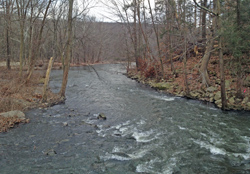Sloatsburg — The waters of the Ramapo River ran fast and murky this past August, overflowing into central Sloatsburg, washing hot tubs down river, overturning diesel tanks, and flooding many Village residents and businesses. Hurricane Irene’s storm surge added to already swollen waterways from summer rains, creating flood conditions along the Ramapo and Mahwah rivers. Agencies across all levels have since acted on the storm’s effects, from the Federal Emergency Management Agency (FEMA) to the New York Legislature and Governor Andrew Cuomo to the office of Town of Ramapo Supervisor Christopher St. Lawrence and Village Halls throughout Rockland County. But the particulars of who pays residents and businesses for storm damage, and where the money comes from, remains murky.
 “We knew she was coming,” said Suffern Deputy Mayor Jo Meegan-Corrigan, referring to Hurricane Irene and the Village’s response to storm damage. “When it was time, we were prepared.” Still, Suffern experienced major flooding, especially in the Squires Gate neighborhood along Lonergan Drive, where the Mahwah River runs widest. Meegan-Coorigan said that the Suffern Fire Department and all other Village agencies were outstanding during the storm’s aftermath.
“We knew she was coming,” said Suffern Deputy Mayor Jo Meegan-Corrigan, referring to Hurricane Irene and the Village’s response to storm damage. “When it was time, we were prepared.” Still, Suffern experienced major flooding, especially in the Squires Gate neighborhood along Lonergan Drive, where the Mahwah River runs widest. Meegan-Coorigan said that the Suffern Fire Department and all other Village agencies were outstanding during the storm’s aftermath.
She said that more can and will be done to help residents who suffered property damage. “We’re completely entrenched,” Meegan-Corrigan said. “We really want to do the right thing by our homeowners.”
 Suffern is hosting an open meeting for area residents affected by Hurricane Irene, especially Suffern homeowners of Squires Gate, Tuesday, January 17 at 6 p.m, at the Suffern Village Hall auditorium. The meeting will focus on three separate but related issues that are trying to be sorted out by state and local governments: FEMA letters of intent for homeowners who suffered severe property damage; tax abatement related to the recent Hurricane Irene Law passed by the NY Legislature and signed by Governor Cuomo; and, Project Hope, a free crisis counseling service funded by FEMA and under the direction of the NYS Office of Mental Health and provided by the Mental Health Association of Rockland County.
Suffern is hosting an open meeting for area residents affected by Hurricane Irene, especially Suffern homeowners of Squires Gate, Tuesday, January 17 at 6 p.m, at the Suffern Village Hall auditorium. The meeting will focus on three separate but related issues that are trying to be sorted out by state and local governments: FEMA letters of intent for homeowners who suffered severe property damage; tax abatement related to the recent Hurricane Irene Law passed by the NY Legislature and signed by Governor Cuomo; and, Project Hope, a free crisis counseling service funded by FEMA and under the direction of the NYS Office of Mental Health and provided by the Mental Health Association of Rockland County.
 Debbie Kelly, Rockland Team Leader for Project Hope, will make a presentation on services her team provides. Chris Jensen from the Rockland Office of Fire and Emergency Services will be on hand to help answer questions regarding the letter of intent process established by FEMA that determines if a resident receives funds and/or qualifies for tax abatement. Suffern Mayor Dagan LaCorte will also speak to provide residents an overview of the village’s efforts and help answer homeowner questions.
Debbie Kelly, Rockland Team Leader for Project Hope, will make a presentation on services her team provides. Chris Jensen from the Rockland Office of Fire and Emergency Services will be on hand to help answer questions regarding the letter of intent process established by FEMA that determines if a resident receives funds and/or qualifies for tax abatement. Suffern Mayor Dagan LaCorte will also speak to provide residents an overview of the village’s efforts and help answer homeowner questions.
Sloatsburg Mayor Carl Wright said that he will attend to et clarity on the complex issues involving the tax abatement process. “I’d like to get concrete information on the mechanics and procedures,” said Wright.
The recent Hurricane Irene law passed by the NY Legislature and signed by Gov. Cuomo provides relief to homeowners or properties that were “catastrophically impacted” by Hurricane Irene and Tropical Storm Lee, which severely flooded Catskill communities two weeks after Irene. The bill states that properties that lost 50% or more of value as a result of flooding can be reassessed on the 2011 Assessment Roll based on post-storm value — even through damage occurred after the 2011 taxable status date.
The bill essentially allows local governments and school districts to reassess properties in federally declared disaster areas retroactively to August 26, or just before Hurricane Irene struck. The kicker is that the program must be adopted by local governments and school districts to make it available to taxpayers. But the lingering question is who pays the bill if a municipality has to essentially buy out a property owner? Each taxing jurisdiction (county, town, village, school district) must pass a resolution opting into the program by January 23, with a deadline set for March 8 for property owners to apply for tax assessment relief.
In any case, homeowners who qualify for storm damage can either receive FEMA funds or, if the property suffered 50% or more of its value, get a reduced tax bill — or, in some cases, a total buy out of the property.
“It’s difficult when we don’t have definitive answers on this matter,” said Wright, who is trying to determine exactly how municipalities are expected to cover abatement expenses. He suggested that any residents who suffered storm damage should attend the Suffern meeting.
“It’s a long process,” said Deputy Mayor Meegan-Corrigan. “Anyone can file for a letter of intent.” But, she continued, if FEMA declares a property has suffered catastrophic damage, “one can never rebuild on that property again” because the area, essentially, will have been declared located in a floodplain. Meegan-Corrigan Tuesday’s meeting will provide a helpful overview on the three complex subjects and should help get homeowner and municipalities on the same page. “This has all come together really fast,” she said.


